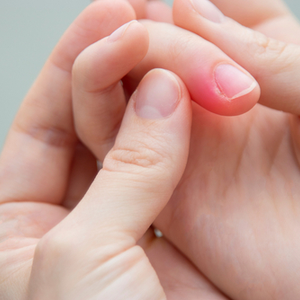
What is an inflammation of the nail bed?
Inflammation of the nail bed (onychia or panaritium subunguale) is a mostly bacterial inflammation of the tissue on which the nail plate rests (nail bed). Inflammation of the nail bed can sometimes spread to the tissue area around the nail plate (nail wall) and is often accompanied by redness, itching and/or pain. In the case of acute nail bed inflammation, pus may also accumulate under the nail. Both toenails and fingernails can be equally affected by inflammation of the nail bed, and in Germany it accounts for about 30 percent of all infections that can occur in the area of the hands.
What types of nail bed infections are there?
Depending on the course of the disease, doctors distinguish between chronic and acute inflammation of the nail bed. Chronic nail bed inflammation is when the inflammation recurs after some time despite successful treatment. Most often, people with a weakened immune system or people who have frequent contact with skin-damaging substances suffer from chronic nail bed inflammation. Acute nail bed inflammation, on the other hand, can affect anyone without the need for special risk factors and is usually more painful than chronic nail bed inflammation. In contrast to chronic nail bed inflammation, the acute form usually affects only one toenail or fingernail.
What causes inflammation of the nail bed?
Nail bed inflammation is usually caused by staphylococcus bacteria. In rare cases, other bacteria, but also fungi (for example, yeast) or viruses (for example, herpes viruses) can cause inflammation of the nail bed. However, it should be emphasised that the bacteria, fungi or viruses can only cause inflammation on damaged skin. Even small wounds or skin irritations are sufficient to allow the pathogens to penetrate the skin.
In particular, women who practice excessive nail care or people who tend to have dry skin often suffer from nail bed inflammation. People with circulatory disorders, diabetes mellitus or chronic neurodermatitis also belong to the risk groups of nail bed inflammation. The same applies to cancer patients and people with a weakened immune system.
What are the symptoms of inflammation of the nail bed?
Inflammation of the nail bed usually manifests itself by a strong reddening of the affected skin area. Especially in the early stages, the skin around the nail bed may also itch. At a later stage, there may also be swelling and a reddish sheen of the skin, and there may be occasional pain that is especially noticeable when pressure is applied. This pain can increase after only a few days and can occur even if the affected fingers or toes are not exposed to irritation.
If the affected skin area is also overheated, this can also indicate an inflammation. In the case of a subungual panaritium, pus usually accumulates under the nail after several days. In addition to severe pain, this can even be accompanied by detachment of the nail plate from the nail bed. However, it is also possible that the pus drains away on its own over the lateral edge of the nail. If there is no bursting of the pus accumulation, surgical opening may be necessary.
In any case, a doctor should be consulted if an inflammation of the nail bed is suspected. If the inflammation is not treated, the growth of the nail may be impaired.
How is inflammation of the nail bed diagnosed?
Healthy people with an intact immune system should observe the nail bed inflammation for a few days. This is because it can usually heal on its own. However, if there is no improvement after about three days or if the symptoms even get worse, you should definitely see a doctor. Patients with a weakened immune system, on the other hand, should consult a doctor in the early stages of nail bed inflammation.
The general practitioner or dermatologist will first take the patient's medical history (anamnesis) by asking for a detailed description of the type, the course and the complaints. The doctor will then probably carry out a physical examination, during which the affected skin areas will be examined in detail. This will usually be enough to make an initial diagnosis. To confirm the diagnosis, the doctor may also take a swab to rule out skin cancer (squamous cell carcinoma), for example, and at the same time determine the pathogen causing the infection.
How is inflammation of the nail bed treated?
If the inflammation of the nail bed is in its initial stage, the patient can usually treat it himself. For example, the affected toenail or fingernail can be bathed several times in warm water. This softens the cornea and the pus can drain off more easily. An additional treatment with camomile alleviates the pain and supports the healing process. In addition to this treatment method, there are a number of home remedies as well as over-the-counter medications that can be used in the treatment of nail bed inflammation. However, if there is no improvement after a few days, a doctor should be consulted to initiate further treatment measures. If, on the other hand, it is a more severe case of inflammation of the nail bed or if the patient is weakened by other diseases, the treatment is usually taken over by the doctor from the outset.
